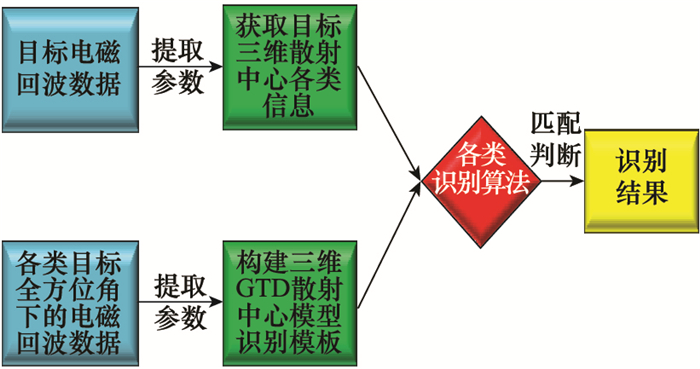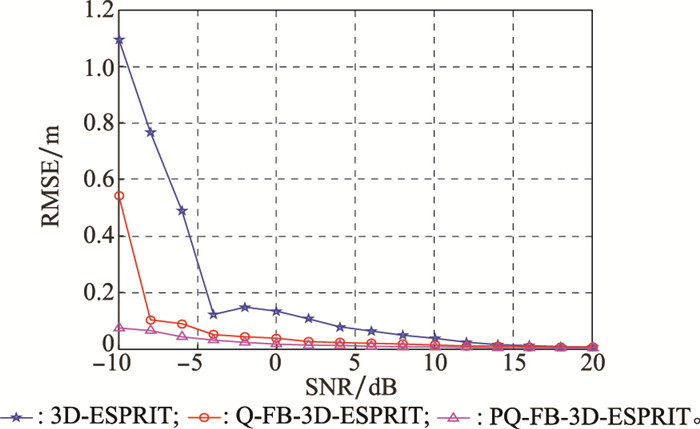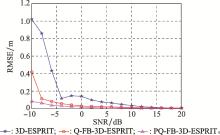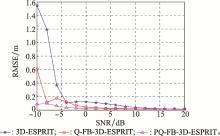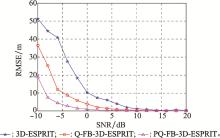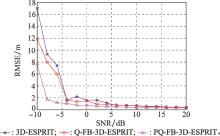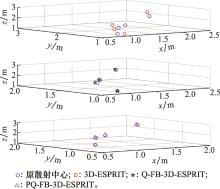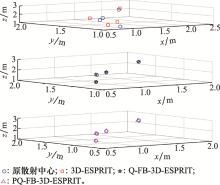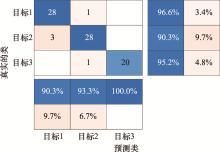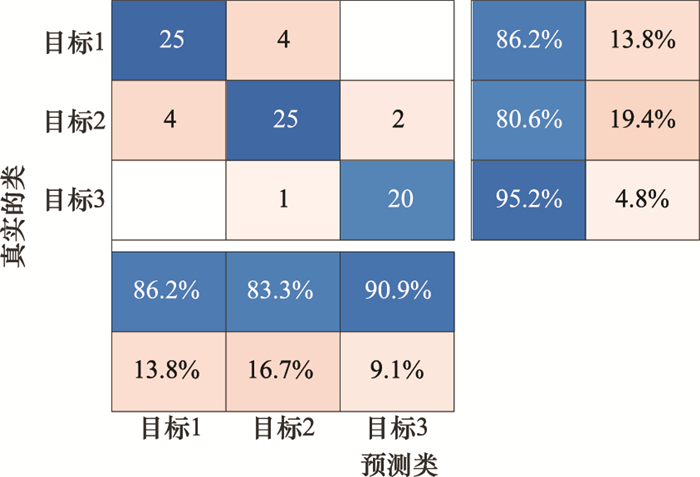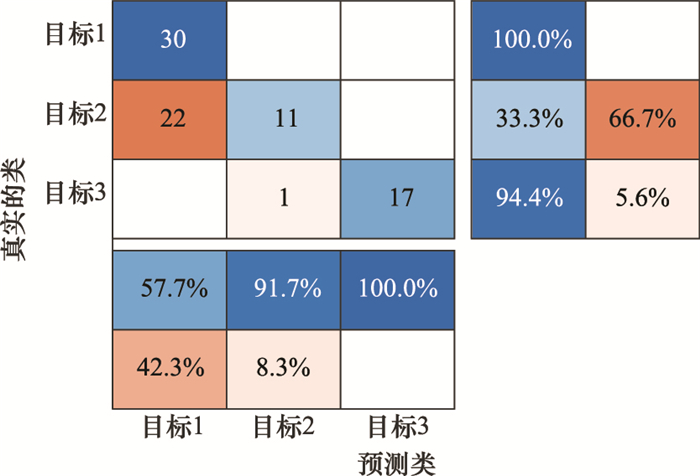Systems Engineering and Electronics ›› 2021, Vol. 43 ›› Issue (2): 336-342.doi: 10.12305/j.issn.1001-506X.2021.02.07
• Electronic Technology • Previous Articles Next Articles
GTD model parameter estimation and target recognition based on improved 3D-ESPRIT algorithm
Jiahua XU1,2( ), Xiaokuan ZHANG2(
), Xiaokuan ZHANG2( ), Shuyu ZHENG1,2(
), Shuyu ZHENG1,2( ), Binfeng ZONG2(
), Binfeng ZONG2( ), Shuchang ZHENG3(
), Shuchang ZHENG3( )
)
- 1. Air and Missile Defense College, Air Force Engineering University, Xi'an 710051, China
2. Graduate school, Air Force Engineering University, Xi'an 710051, China
3. Xi'an University of Architecture and Technology, Xi'an 710055, China
-
Received:2020-05-19Online:2021-02-01Published:2021-03-16
CLC Number:
Cite this article
Jiahua XU, Xiaokuan ZHANG, Shuyu ZHENG, Binfeng ZONG, Shuchang ZHENG. GTD model parameter estimation and target recognition based on improved 3D-ESPRIT algorithm[J]. Systems Engineering and Electronics, 2021, 43(2): 336-342.
share this article
| 1 |
POTTER L C , CHIANG D M , CARRIERE R . A GTD-based parametric model for radar scattering[J]. IEEE Trans.on Antennas and Propagation, 1995, 43 (10): 1058- 1066.
doi: 10.1109/8.467641 |
| 2 |
DING B Y , WEN G J . A region matching approach based on 3D scattering center model with application to SAR target recognition[J]. IEEE Sensors Journal, 2018, 18 (11): 4623- 4632.
doi: 10.1109/JSEN.2018.2828307 |
| 3 |
LI T L , DU L . SAR automatic target recognition based on attribute scattering center model and discriminative dictionary learning[J]. IEEE Sensors Journal, 2019, 19 (12): 4598- 4611.
doi: 10.1109/JSEN.2019.2901050 |
| 4 | ZHOU J X , SHI Z G , CHENG X , et al. Automatic target recognition of SAR images based on global scatt ering center model[J]. IEEE Trans.on Geoscience and Remote Sensing, 2011, 19 (10): 3713- 3729. |
| 5 | 邱志强.基于空间谱估计的雷达目标散射中心提取研究[D].成都: 电子科技大学, 2016. |
| QIU Z Q. Research on radar target scattering center extraction on the spatial estimation algorithm[D]. Chengdu: University of Electronic Science and Technology of china, 2016. | |
| 6 | 钟金荣.目标三维电磁散射参数化模型反演方法研究[D].长沙: 国防科学技术大学, 2016. |
| ZHONG J R. Inverse methods for three dimensional parametric scattering model of target[D]. Changsha: National University of Defense Technology, 2016. | |
| 7 | ZHAO Y , ZHANG L , JIU B , et al. Three-dimensional reconstruction for space targets with multistatic inverse synthetic aperture radar systems[J]. EURASIP Journal on Advances in Signal Processing, 2019, 40. |
| 8 | 王旭东, 仲倩, 闫贺, 等. 一种二维信号波达方向估计的改进多重信号分类算法[J]. 电子与信息学报, 2019, 41 (9): 2137- 2142. |
| WANG X D , ZHONG Q , YAN H , et al. An improved MUSIC algorithm for two dimensional direction of arrival estimation[J]. Journal of Electronics & Information Technology, 2019, 41 (9): 2137- 2142. | |
| 9 |
ANDREW L K , INDER J G . A modified MUSIC algorithm for direction of arrival estimation in the presence of antenna array manifold mismatch[J]. IEEE on Antennas and Propagation, 2016, 64 (11): 4836- 4847.
doi: 10.1109/TAP.2016.2600700 |
| 10 | 郑舒予, 张小宽, 宗彬锋. 基于改进MUSIC算法的散射中心参数提取及RCS重构[J]. 系统工程与电子技术, 2019, 42 (1): 76- 82. |
| ZHENG S Y , ZHANG X K , ZONG B F . Extraction of scattering center parameters and reconstruction of RCS based on improved MUSIC algorithm[J]. Systems Engineering and Electronics, 2019, 42 (1): 76- 82. | |
| 11 |
LEYMEN S , KONSTANTIN U S , PIERRE C . Multidimensional ESPRIT for damped and undamped signals: algorithm, computations, and perturbation analysis[J]. IEEE Trans.on Signal Processing, 2017, 65 (22): 5897- 5910.
doi: 10.1109/TSP.2017.2736512 |
| 12 | ZHANG W , ZHANG X F , SUN H P , et al. Non-circular generalised-ESPRIT algorithm for direction of arrival estimation[J]. IET Radar, Sonar & Navigation, 2017, 11 (5): 736- 744. |
| 13 |
ZHENG S Y , ZHANG X K , ZONG B F , et al. Parameter esti mation of the 2D-GTD model and RCS reconstruction based on an improved 2D-ESPRIT algorithm[J]. International Journal of RF and Microwave Computer-Aided Engineering, 2020, 30 (7)
doi: 10.1002/mmce.22230 |
| 14 | 张小宽, 郑舒予, 赵唯辰, 等.基于改进2D-ESRIT算法的二维GTD模型参数估计[J].华南理工大学学报(自然科学版), 2020, 48(5): 75-82. |
| ZHANG X K, ZHENG S Y, ZHAO W C, et al Parameter estimation of 2D-GTD model based on the improved 2D-ESPRIT algorithm[J]. Journal of South China University of Technology(Natural Science Edition), 2020, 48(5): 75-82. | |
| 15 | LI H W, ZHANG L, JIANG C Q, et al. Joint TOA and DOA estimation based on improved matrix pencil method[C]//Proc.of the IEEE 4th International Conference on Computer and Communications, 2009. |
| 16 | 郑舒予, 张小宽, 宗彬锋, 等.二维GTD模型参数估计的PQ-FB-2D-ESPRIT[J].系统工程与电子技术, 2020, 42(6): 1283-1289. |
| ZHENG S Y, ZHANG X K, ZONG B F, et al. PQ-FB-2D-ESPRIT algorithm for parameter estimation of 2D-GTD model[J]. 2020, 42(6): 1283-1289. | |
| 17 | 温晓杨, 石志广, 赵宏钟, 等. 一种基于3D-ESPRIT的散射中心参数估计算法[J]. 雷达科学与技术, 2007, 5 (2): 119- 123. |
| WEN X Y , SHI Z G , ZHAO H Z , et al. A 3D-ESPRIT method for radar target scattering centers parameters estimation[J]. Radar Science and Technology, 2007, 5 (2): 119- 123. | |
| 18 | 王菁.光学区雷达目标散射中心提取及其应用研究[D].南京: 南京航空航天大学, 2010. |
| WANG J. A study on radar optical region target scattering center extraction and its applications[D]. Nanjing: Nanjing University of Aeronautics and Astronautics, 2010. | |
| 19 | JACHSON J A, MOSES R L. Feature extraction algroithm for 3D scene modeling and visualization usin g monostatic SAR[C]//Proc.of the SPIE 6237, Algorithms for Synthetic Aperture Radar Imagery XⅢ, 2006. |
| 20 | 郑舒予, 张小宽, 宗彬锋, 等. 基于改进3D-ESPRIT算法的三维GTD模型参数估计[J]. 北京邮电大学学报, 2020, 43 (4): 32- 38. |
| ZHENG S Y , ZHANG X K , ZONG B F , et al. Parameter estimation of the 3D-GTD model based on a modified 3D-ESPRIT algorithm[J]. Journal of Beijing University of Posts and Telecommunications, 2020, 43 (4): 32- 38. | |
| 21 |
SARAH M E , SUTHARSHAN R , SHANIKA K , et al. High-dimensional and large-scale anomaly detection using a li-near one-class SVM with deep learning[J]. Pattern Recognition, 2016, 58, 121- 134.
doi: 10.1016/j.patcog.2016.03.028 |
| 22 | DING J , CHEN B , LIU H W , et al. Convolutional neural network with data augmentation for SAR target recognition[J]. IEEE Geoscience and Remote Sensing, 2016, 13 (3): 364- 368. |
| 23 |
MOHAMMAD A A . Single and multiple outputs decision tree classification using bi-level discrete-con tinues genetic algorithm[J]. Pattern Recognition, 2019, 128, 190- 196.
doi: 10.1016/j.patrec.2019.09.001 |
| 24 |
SUN Y , LIU Z P , TODOROVIC S , et al. Adaptive boosting for SAR automatic target recognition[J]. IEEE Trans.on Aerospace and Electronic Systems, 2007, 43 (1): 112- 125.
doi: 10.1109/TAES.2007.357120 |
| [1] | Yili HU, Yongbo ZHAO, Sheng CHEN, Ben NIU. Decoherence of conformal electromagnetic vector sensor array by double interpolation fitting method [J]. Systems Engineering and Electronics, 2022, 44(8): 2393-2402. |
| [2] | Caiyun WANG, Yida WU, Jianing WANG, Lu MA, Huanyue ZHAO. SAR image target recognition based on combinatorial optimization convolutional neural network [J]. Systems Engineering and Electronics, 2022, 44(8): 2483-2487. |
| [3] | Yuanyi XIONG, Wenchong XIE. Adaptive iterative monopulse estimation method based on space-time constraint [J]. Systems Engineering and Electronics, 2022, 44(8): 2506-2514. |
| [4] | Wenjie YUAN, Kunyi GUO, Xinqing SHENG, Congjun JIN. Modeling method of sliding scattering center based on current phase characteristics [J]. Systems Engineering and Electronics, 2022, 44(6): 1765-1771. |
| [5] | Jingming SUN, Shengkang YU, Jun SUN. Radar small sample target recognition method based on meta learning and its improvement [J]. Systems Engineering and Electronics, 2022, 44(6): 1839-1845. |
| [6] | Xiaoling ZHOU, Zhaoxia ZHANG, Ya LU, Qian WANG, Kunkun WANG. SAR image recognition based on improved R-FCN [J]. Systems Engineering and Electronics, 2022, 44(4): 1202-1209. |
| [7] | Yan JIN, Dadi ZHAO, Hongbing JI. Parameter estimation of LFM signals based on NAT functions in impulsive noise [J]. Systems Engineering and Electronics, 2022, 44(3): 762-770. |
| [8] | Jingming SUN, Shengkang YU, Jun SUN. Pose sensitivity analysis of HRRP recognition based on deep learning [J]. Systems Engineering and Electronics, 2022, 44(3): 802-807. |
| [9] | Yu LEI, Xiangguang LENG, Xiaoyan ZHOU, Zhongzhen SUN, Kefeng JI. Recognition method of ship target in complex SAR image based on improved ResNet network [J]. Systems Engineering and Electronics, 2022, 44(12): 3652-3660. |
| [10] | Yuchao YANG, Ming FANG, Chenfan ZHAO, Yueqi WANG, Gang FANG. Research on long-time coherent integration and parameter estimation algorithm of high-speed maneuvering targets [J]. Systems Engineering and Electronics, 2022, 44(12): 3811-3820. |
| [11] | Qi LIU, Xinyu ZHANG, Yongxiang LIU. Few-shot SAR target recognition based on gated multi-scale matching network [J]. Systems Engineering and Electronics, 2022, 44(11): 3346-3356. |
| [12] | Caiyun WANG, Chen YAO, Yida WU, Jianing WANG, Xiaofei LI, Panpan HUANG. Radar target recognition based on improved Dijkstra algorithm with time-frequency domain filtering [J]. Systems Engineering and Electronics, 2022, 44(10): 3090-3095. |
| [13] | Zengmao CHEN, Li LU, Zhiguo SUN, Rongchen SUN. Parameter estimation algorithm of convolutional codes with solving cost function based on conjugate gradient [J]. Systems Engineering and Electronics, 2022, 44(10): 3235-3242. |
| [14] | Yiheng ZHOU, Jun YANG, Saiqiang XIA, Mingjiu LYU. Estimation method of micro-motion parameters for rotor targets under flashing [J]. Systems Engineering and Electronics, 2022, 44(1): 54-63. |
| [15] | Xin GUAN, Haotian YU, Xiao YI. Research on evidence independence and its influence on target recognition [J]. Systems Engineering and Electronics, 2022, 44(1): 192-198. |
| Viewed | ||||||
|
Full text |
|
|||||
|
Abstract |
|
|||||

